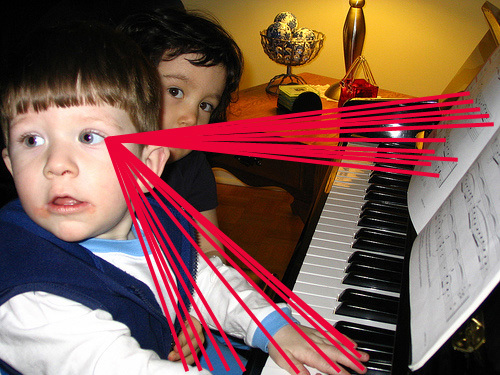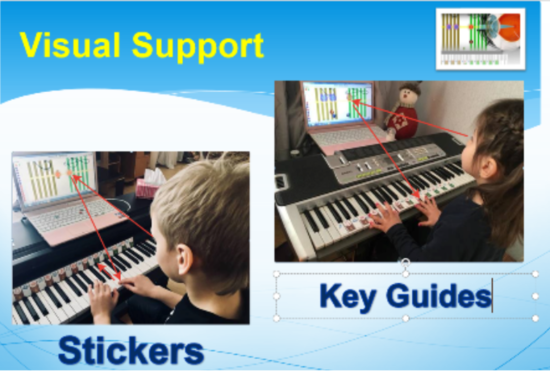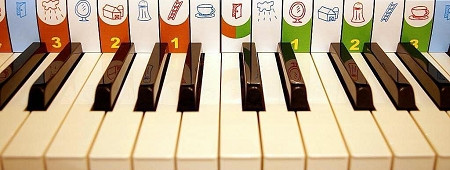Preparatory B (from 3 to 5). Lesson 45
Previous Lesson Next Lesson
To all lessons

Your FREE Demo version is here
Your full version access is here
Do you understand better now that your toddler's attention is energy and any 'leaks' weakens this source?
Internet is overloaded with the pictures of inattentive students at the pianos. If a child on a picture or a video wonders around and looking anywhere else, but keys and music notes, his attention is under risk of loosing all energy to the point of complete frustration and lose of interest. 
To avoid this from happening you as an instructor should let your toddler
To See the Key
In order to find the key that corresponds to a specific note, a student has to physically transfer visual focus from the music notation space to that of a keyboard. This is not an easy “project” for an untrained eye.
A synthesizer with stickers is the most convenient way of finding the keys, as the picture with the name of the note is right at the fingertips of a player. That is why it is best to use stickers for presentations and initial lessons with beginners.
As I previously mentioned, even in this case students might not be able to see and identify the desired key right away. To make it easier on the eye and to release attention, we can partially cover the keyboard or computer screen.
If a child finds the right key quickly, you can gradually make the task more difficult.
Once the toddler learns to shift his focus from music notation to the key, it's time to start working on a piano piece.
The best way to do it is to take a short passage of a piano piece, between 4 and 8 notes in length, and ask him to play it.
If playing time on the timer interval does not exceed the amount of notes played (for example, 4 notes played in 3 seconds), the attention of your child is ready for further development of the focal concentration.
Synthesizer with tabs (Key Guides) requires more attention: the student must shift visual focus from the music note to the picture and make sure that the picture corresponds to the key.

As a rule, the timer of the Gentle Piano immediately reflects this seemingly minor complication – the rate of delay increases. It tells us that attention has partially shifted towards solving physical problems.
Stickers can be replaced by music tabs (Piano Key Guides) once the student can play piano pieces at low rates of delay, almost without looking at his hands.
Using the keys without stickers and tabs is the most complex problem for a beginner. As a rule, the attention is directed towards solving physical problems:
- to see what to play,
- to find what to press, and
- to decide how much force to apply.
There are different methods that allow the novice to see the note and the key with “traditional” music notation and bare keys: white key search by location of black keys; memorizing the position of each note, and teacher’s tips. As stated earlier, these methods lead to attention overload.
If a student needs more than a second to find a note and a key, his attention is working overtime. Not only it doesn’t accumulate energy, it actually depletes it.
...
Piano Hand Position Exercises by Olga Egorova: "Command your fingers"
This exercise drives the beginner's attention to the awareness of each finger, grouped and placed as a dome on the keys. Particular attention is paid to the weakest fingers of the hand - ring and pinky. If you perform this exercise daily, even your weakest fingers, will gradually develop their flexibility, independence and strength. Exercises prepared by Olga Mikhailovna Egorova, certified Soft Mozart Academy teacher (Moscow, Russia)
....
![]() Treble Staff Puzzle® - This is the last week of work on the module. Be sure to take a photo - video for posting in your progress diary.
Treble Staff Puzzle® - This is the last week of work on the module. Be sure to take a photo - video for posting in your progress diary.
....
 If your child is developing faster or slower than our plans suggest, we recommend writing to us at admin@softmozart.com to start working with our certified specialists.
If your child is developing faster or slower than our plans suggest, we recommend writing to us at admin@softmozart.com to start working with our certified specialists.
 Gentle Piano®
Gentle Piano®
1. "Little dog gone" from the Nursery 1 Album
we try to make the minimum number of mistakes with the minimum lag on RH, LH, PH
Be sure to write down the result!
2. Prokofiev "Peter and the Wolf" - "Cat's Theme": download the LMZ file and add to the library. Play R1
....
Listen to Prokofiev "Peter and the Wolf" - "Cat's Theme":
....
Visit our Soft Mozart forum and start your progress diary here. Use the current year section. This is the place for you to ask questions and share your experiences.
At least 2 photos and 1-2 videos of the listed activities will count towards your child's credits for the graduation DIPLOMA. Please upload the video to You Tube, copy the address from the BROWSER window and paste it into your Progress Diary. Do not forget to indicate the year and type of work in the description of your Soft Mozart Academy photo / video.
Sincerely Yours,
Hellene Hiner

Video success:
 Would you like to receive lessons by email weekly? Subscribe to the e-mail lesson here:
Would you like to receive lessons by email weekly? Subscribe to the e-mail lesson here:
All the lesson plans:
For 2+ students
For students from 3 to 5
For students 5+
Always check here, if we have any recital! You and your child will benefit a lot from participating in our concerts!
Your place to start your progress diary is here.

